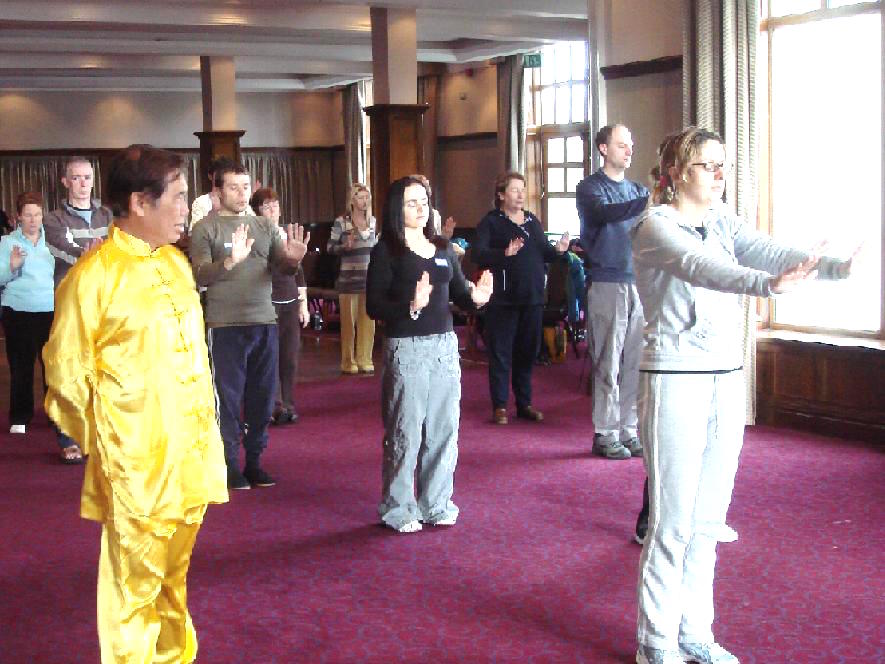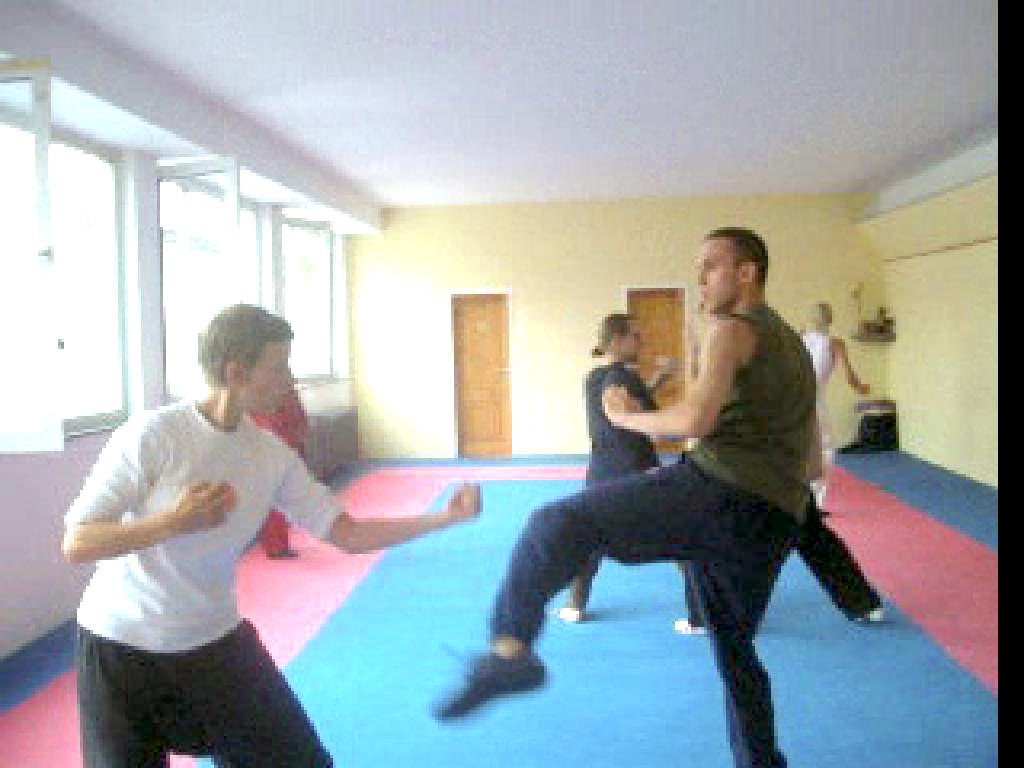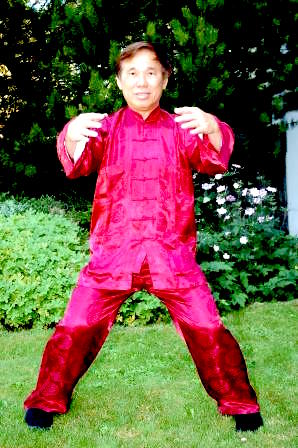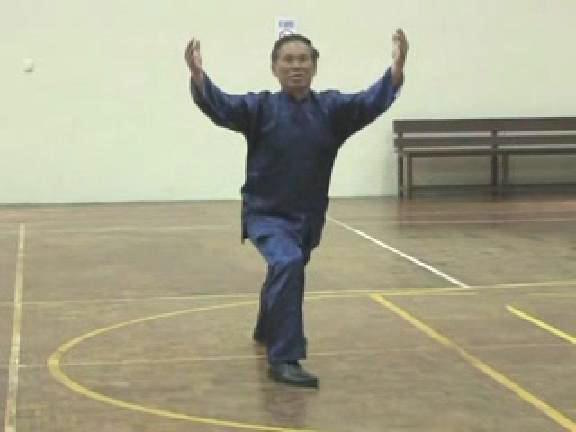SELECTION OF QUESTIONS AND ANSWERS
SEPTEMBER 2010 PART 2

A regional chi kung course in Ireland
Question 1
I am currently teaching two students Shaolinquan, although I have not formally started any courses. This was because they were the first batch of qigong students and were very keen to learn the Shaolin martial arts. Both of them are not in optimal physical condition, one being diabtetic and another fairly elderly with a bad knee.
I am teaching them a basic course for 6 months up to Level 5, if feasible at the cost of S$100 a month each. The S$100 is half the price of the regular fee because they are part of the inaugural qigong course and I had promised them a 50% discount on all courses they take with me.
— Sifu Zhang Wuji, Singapore
Answer
I would regard teaching the two students as personalized teaching. The fees, therefore, should be higher. As a guideline, I would charge them for a similar amount I would get from a regular class given a similar amount of time in teaching.
If I charge a student S$200 per month in a regular class, which should have at least 20 students, my total gross income from the class will be S$4000. If there are two students, each one should pay S$2000. If I give them a 50% discount as pioneer students, each would pay S$1000 per month for my personalized teaching.
Understandably other people may think we are crazy, or crazy for money, charging S$1000 per month for a kungfu course. Of course this is untrue. The truth is that charging this fee is for the students' benefits. This will become clear as the explanation unfolds.
Other people, including the two students if you charge them only S$100 per month, view kungfu from the common-man's perspective. From this perspective, S$100 a month is expensive. One can learn kungfu of the common-man for S$50 or even S$30 per month. He will also be in a bigger class where he has more classmates to socialize with.
We are not teaching common-man kungfu; we are teaching kungfu meant for emperors and generals. Paying S$1000 per month for such elite kungfu is cheap. More importantly, elite kungfu is very rare today. It doesn't mean that if a student is willing to pay S$1000 per month, the master will teach him.
If you are crazy for money, you would not teach them even if they are willing to pay S$1000 per month. Your professional fees are at S$500 per hour. S$1000 per month is only a small portion of your professional fees.
I suggest that you charge them S$1000 per month each or teach them for free. They should be keemly aware that the fees are probably the least important part of their being your students. More important parts are their following the Ten Shaolin Laws and following your instructions, especially the instruction of practicing daily or at least regularly on their own. If they fail in these requirements, you will terminate your teaching, irrespective of whether they are paying fees or learning for free.
We are very clear about the difference between common-man kungfu and elite kungfu. Most other people may not know, and it is fair for them to ask. We can explain the difference in many ways. For the purpose here, a short answer is that the main and often the sole benefit of common-man kungfu is socialization with one's classmates, whereas the benefits of elite kingfu are good health, vitality, longevity, mental freshness, spiritual joys and combat efficiency.
Don't those who practice common-man kungfu aim to have good health and combat efficiency too? They may aim to, but they don't have these benefits, often without their own knowing. Indeed, many of them become more unhealthy as a result of their training, and they cannot use kungfu to defend themselves though some of them may be good at using other martial techniques to hurt others, including their classmates.
Question 2
As both students have physical limitations, which unfortunately have not been resolved after a year of qigong, I have had to make several adjustments to their Shaolin training, for example, focusing on the Goat Stance for stance training, and modifying the Bow Arrow stance to look more like a Four-Six step (in reverse) so there is less pressure on the knees. Even with much reduced intensity, they are panting and sweating heavily after a short sequence of footwork training.
Answer
These modifications are correct. The vigorous kungfu movements can help one of the students lose weight, and correct knee rotation can help the other strengthen his knees.
But a better alternative is for them to get well first before starting Shaolin Kungfu. This is in line with the kungfu tenet, "xian chang sun, hou fang sun", or "first strengthen the body, only then think of combat". There is no urgency for them to practice Shaolin Kungfu. They don't need it for combat, for example. They should focus on practicing qigong to get well before commencing Shaolin Kungfu.
Qigong is actually very scientific: if one does certain actions, he will get certain predictable results. For example, if he tenses his muscles, he will block his qi flow. If he does not perform the qigong exercise in a qigong state of mind, he will only get physical exercise benefits.
On the other hand, if he practices qigong correctly and regularly, he will get good health, vitaltiy and longevity. This is as sure as if he drinks some water he will quench his thirst, if he eats some food he will satisfy his hunger.
If he does not get these results, then something is wrong. This "something wrong" can be traced to one, two or all of the following three factors:
- The method.
- The teacher.
- The student.
Here, the method and the teacher are correct. Our method has helped literally thousands of people overcome pain and illness. You are a trained, certified instructor, with the students' interest at heart. The fault probably lies with the student.
The student's fault can be traced to one, more or all of the following factors.
- He has not practiced regularly or sufficiently.
- He has not practiced correctly.
- The effect of his training is working on his deep-rooted problem which he may not know.
- The negative factors causing his problems are still prevalent, and negate the good effects of his qigong training.
- He worries or intellectualizes too much, which negates the good effects of his training and may even bring adverse effects.
Check with the two students against this list, and you will most probably help them to solve their problems.
The first two factors, not practicing regularly or sufficiently, and not practicing correctly, are the two most important. They make up about 75% of those who do not obtain good results.
The most wide-spread reasons for not practicing correctly are tensing their muscles, not relaxing enough to go into a qi flow, thinking or worrying, and overtly looking for qi sensations.

A regional Shaolin Kungfu class in Germany
Question 3
I would like to have Sifu's advice on how to teach older or more infirm students. My approach now is to take things very slowly and making modifications when necessary. When they are stronger, I will get them to train the standard mode.
However, I am not sure if this is the best way to teach. As they are progressing very slowly, it is also easy for them to get bored, so I have to teach some of the syllabus in advance to keep things interesting, even though the foundation may not be there.
Answer
Although this does not apply to you, a good kungfu or qigong teacher must take care not to appease his students. This, I believe, was a main reason why some excellent teachers in the past acted tough on their students though in their heart they were soft and kind.
I often use this approach, and without fail it always brings excellent results for those who follow my instructions. When Peter and Gillian, who were already 2nd dan black-belts in Taekwondo, first learned Shaolin Kungfu from me, I taught them only the Horse-Riding Stance and asked them to practice it daily.
Gillian complained to her mother, Jean, that other students were very lucky; they learned how to fight in a five-day course. Jean told her that she was very lucky as I was teaching her the master's way. True enough, a year later when I saw Peter and Gillian again, they had developed so much internal force from their stance training that for them learning Shaolin Kungfu was a matter of picking up some useful techniques. Gillian became so powerful that would-be assailants were hurt when she gently tapped on them.
A young woman was run over by a truck. Although the surgeons did an excellent job fixing her crushed pelvis, they were doubtful whether she could ever be normal again. When her father invited me to give her qigong healing in the hospital, she said she was uncertain of this "voodoo". I gave her a severe thrashing -- verbally -- so much so that she became an obedient student. She was on a walker then, unable to stand on her own feet. I told her to walk out of the hospital within a week. She did -- without the walker. She later graduated in medicine herself, and is now happy and healthy.
If you treat your older and weaker students as old and weak, they will remain old and weak. Tell them to become young and strong, despite their age and infirm condition. Of course they do not become young and strong over-night, or even in a month or two. If they are 60 now, or have to pause a few times to rest while going up a slope, tell them that in a year's time they will feel and look like 55, and be able to walk up a slope briskly without panting.
We do not just set the vision and the direction, but also provide the tools with which the students work on to achieve their goals. If they just travel on, i.e. practice correctly every day, arriving is a matter of time.
Of course we do not treat an old or infirm student as if he were young and strong. We ask him to become young and strong, and give him the tools to do so. He has to use the tools. But most important of all, he must want to be young and strong, want it enough to put in time and effort to realize the vision.
When he first starts, we do not expect him to bounce about like his young classmates at 20. If his classmates can sit low at a Horse-Riding Stance for 10 minutes, due to his age or infirmity, he may not be able to sit as low or as long. Let us graduate the levels from standing upright to sitting at the stance at perfect height as 1 to 10. His younger classmates may be at 6 for 10 minutes, whereas he may be just at 3 for 4 minutes.
Now, we do not tell him to sit at level 3 for 4 minutes throughout his kungfu training. We tell him that is his starting point, but with correct daily practice after some time he should be able to sit at level 6 for 10 minutes. We also teach him supplementary exercises to loosen his tight muscles.
This "some time" may be a few weeks or a few months. By then his younger classmates may have progressed to level 8 or even level 10 for 15 or more minutes. If this elderly student continues his daily practice, he too can eventually reach level 10 for 15 or more minutes.
Let us suppose he needs 8 months of daily practice to reach the first attainment of level 6 for 10 minutes, and another 4 months to reach the second attainment of level 10 for 15 minutes, whereas his younger classmates can reach this attainment after only 5 months. Well, this is the price he has to pay for a weak start. He has to put in more time and effort to attain the same results of those who have a better start, and this is well expressed in some excellent advice I learned from my father years ago, namely "cheong kern poh khuit" (Cantonese), which means "use diligence to compensate for weakness".
But the significant point is that after 8 months of daily practice, this elderly student will be as good as young people at 20, and after a year he will be better than them. In other words, if old and infirm students faithfully follow our training programme, in a year's time they can be fitter and healthier than many young people today!
One year is a reasonable time to expect them to have remarkable progress. It is in fact a conservative expectation. In my Intensive Chi Kung Course now and some of my regional Sinew Metamorphosis courses, students who are elderly and who may not have run for a long time, can run round the training hall about ten times, which is about the distance round a football field, without being tired and without panting! Most young people today will be panting and tired running half a football field.
Question 4
I also sense that one of my students is becoming disillusioned. He started learning qigong with the high hopes that his diabetes could be cured, and I believe he expressed the same sentiment to Sifu last year too, to which Sifu said he would be cured in 6 months. I think he has taken the timeline too literally and may be feeling disappointed
Answer
I meant the timeline literally. I might have said "would" though I think most probably I said "should", but certainly I did not say "will".
I am quite particular in using "should" or even "would" because that is what I want to say, i.e. if a student practices our qigong diligently, he should be cured of his illness within nine months, and sometimes within six months. This is of much significance because many people wrongly think that their illness, like diabetes, asthma or cancer, cannot be cured at all.
I am very particular that I do not imply that the illness will certainly be cured, or the student is guaranteed to be cured.
Going over with him the factors why he is still not cured of his illness will be helpful.

Carrying the Cosmos
Question 5
I recall I took more than 2 years for my sinus problem to subside. My question is how I can encourage him at this point.
Answer
Telling him of your own experience can encourage him.
Another excellent encouragement is to ask him work on Anthony's progress chart. Anthony asks his students to answer a list of health questions at regular intervals, like whether they feel more relaxed, less prone to anger, experience less pain, have more jest in their work, etc. The students discover that even if their main health problem remains, they have benefited much in other health areas.
Your father is a wonderful inspiration. He cured his diabetes in a few days of the Intensive Chi Kung Course. But his is an exception.
Most people would have their diabetes cured in about 9 months. If a student still suffers from diabetes after a year of training, it is also an exception.
It will be helpful to tell our students that while miracles do happen in our school, they should not crave for miraculous results in their practice. They should regard their practice as a daily, but enjoyable task, like eating their breakfast or going to work. If benefits come, fine; it not, it doesn't matter.
However, it is not an ordinary task. It is a task for the elite. It is a task that can bring wonderful benefits like good health, vitality and longevity.
Is this a contradiction? On one hand we ask our students not to crave for miraculous results. On the other, we tell them ours is an elite art that brings wonderful benefits. No, it isn't a contradiction. It is a manifestation of yin-yang harmony. We know ours is an elite art, and we set aims and objectives accordingly, yet we do not crave for the results to an extent that we become frustrated if the results do not come within the time we want.
Let us take a rough analogy. Suppose you have a good car. You know it is comfortable and reliable, and will take you to your destinations. You want to drive to the beach and expect to reach there in half an hour. But due to some unforeseeable factors, like a street procession or traffic jam, you are still not at your destination after driving for three-quarters of an hour. Do you dump your car? No, you still enjoy your drive.
Question 6
A follow up question is whether I am in any position to emphatically tell the students that their illness can be cured. This diabetes student is one example of how a student may have unrealistic expectations.
Answer
Yes, we should emphatically and confidently tell our sick students that their illness can be cured. This is telling the truth. It is of particular importance to those who have perverted views that they have to suffer from their illness for life.
Saying that their illness can be cured is different from saying that they will certainly be cured. Our students and we ourselves must be clear about this difference.
In the same way, in a free society like Singapore, everyone can be rich. But this does not mean everyone will be rich. To be rich or healthy, one must put in the right, and honorable, effort.
In Chinese medical philosophy, there is no such a thing as an incurable disease. But this does not mean that every patient can recover. Even when he suffers from an easily curable disease, but if the disease has gone beyond a threshold, or if he does not take his medication properly, or if for some unconscious reasons he does not want to be cured, he will not recover.
The reason why the diabetes student still suffers from diabetes is not because diabetes cannot be cured but because of other factors, one of which could be his unrealistic expectations.
Editorial Note: Sifu Zhang Wuji's other questions can be found here, here, and here.

Embracing the Sun
Question 7
Can you tell me more about the Zhan Zhuang pattern "Embracing The Cosmos"
— Paschal, Ireland
Answer
Another and more widely known name for "Embracing the Cosmos" is "Three-Circle Stance". It is an excellent zhan zhuang posture for developing internal force. It helps to focus chi or vital energy at the dan tian as well as let it flow round the body, thus achieving both the building aspect and the circulating aspect at the same time.
As it is very frequently used in Taijiquan, becoming its fundamental internal force training method, it is sometimes called the Taiji Stance. This may be misleading because "Embracing the Cosmos" or the "Three-Circle Stance" is also found in other styles of kungfu.
Do not confuse "Embracing the Cosmos" with "Embracing the Sun", which is another zhan zhuang posture used in our school, though it is not as popular. When practicing "Embracing the Sun", the practitioner uses a Bow-Arrow Stance and hold his two hands in a big circle resembling the sun in fromt of his head. In "Embracing the Cosmos", the Goat-Stance is used, with the two arms forming a crcle in front of his chest.
The term "Embracing the Cosmos" is sometimes used for a chi kung exercise whereby a practitioner stands upright with his feet together and his arm holding a big circle in front of his chest. Without moving his feet, he turns his whole body and arms in a big arc to one side, then to the other. It is an excellent exercise to overcome back pain and nerve problems.
How is it possible that the same term is used for a zhan zhuang posture and also for a chi kung exercise? Can this cause confusion?
This is because due to differences in histroy, geography and other factors, terms in chi kung and kungfu, unlike in science, are not exclusive. In other words it is not true that in chi kung or kungfu, one particular term is always used for the same particular movement or pattern. Chi kung and kungfu terms are meant for easy reference; they are not rigid definition. Generally there is no confusion because those involved usually know what they are referring to.
Question 8
What is the best way to integrate it into my practice?
Answer
An effective way to practice "Embracing the Cosmos" is right at the start or right at the end of every training session. After the stance training, you should bring your feet togerther, let go and enjoy a chi flow.
This part is very important, and was poetically described in the past as "flowing breeze, swaying willows". If the chi flow was vigorous, it was described as "flowing water, floating clouds". But today it is frequently neglected by most practitioners. Moreover, many practitioners do not know how to go into a chi flow, without which it degenerates into a physical exercise, and not an energy exercise.
LINKS
Selected Reading
- The Magic Formula of Addition and Subtraction
- Versatility of Lazy Monkey Plucks Fruit
- Vegetarian Delights
- Chi Kung - The Art of Developing Energy
- Some Interesting Questions on Internal Force
